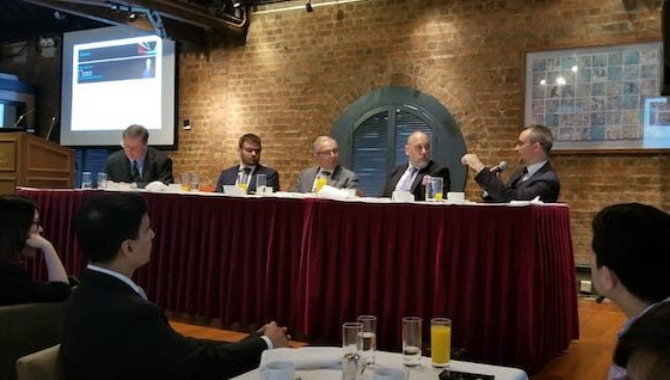
The latest Asia Maritime Breakfast Briefing at the Foreign Correspondents Club in Hong Kong was on the subject of hazardous goods and proved to be a timely event.
Incidents of containership and bulk carrier fires are being reported on a weekly basis, many serious and some even leading to fatalities.
Whatever the reason. Despite many years, many adverse experiences, the loss of many lives, and the introduction of myriad regulations there remain an unacceptable number of incidents relating to the carriage of hazardous cargoes. The figures speak for themselves.
In April, Intercargo revealed that over the past 10 years more than half the 188 fatalities recorded from 48 bulk carrier losses were directly attributable to cargo failure or liquefaction, a situation likely aggravated by the failure of flag states to submit timely investigation reports.
In September 2018 a prominent P&I Club noted that shipboard container fires are breaking out on a weekly basis and major fires that present a threat to life are happening on average every two months.
The panel of experts gathered for the Briefing constituted a broad range of expertise including forensic investigator, Dr John Allum, regional director of Hawkins, the ABS director of Market Sector Containerships, Jan Otto de Kat, Andre Rigden Green , partner, Stephenson Harwood, and Dimitris Seirinakis, managing director of the Shanghai branch of Shipowners Claims Bureau, managers of the American P&I Club. Each member of the panel was tasked with identifying possible causative factors behind hazardous cargo incidents and suggesting some solutions.
The presentation by Dr Allum revealed the endless possibilities for calamitous explosions or fires from the carriage of problem cargoes such as calcium hypochlorite, charcoal, lithium-ion batteries, scrap metal, or thiourea dioxide – a chemical used in reductive bleaching in textiles. Some spectacular videos illustrated how easily seemingly innocuous cargoes such as scrap steel can become volatile when exposed to heavy rain, for example. Dr Allum maintained that an important factor in reducing the risk would be if crew could be more familiar with the risk they are facing in the first place.
Dr Allum noted that under the Safety of Life at Sea Convention (SOLAS) the IMDG (packaged dangerous goods) and IMSBC (cargoes which may liquefy if shipped at moisture content in excess of their transportable limit) codes were great in providing endless work for experts such as himself and others, they are not very practical.
He insisted that it should be possible to “go back to shippers and offer them a simple code that explains what needs to be done to make the cargo safe.” A sort of guide to the actual codes.
It is an established fact that misdeclared cargo is a major culprit in the occurrence of hazardous cargo incidents, According to published government inspections up to 1.3m boxes may be badly packed or incorrectly identified. Other figures suggest some 150,000 containers contain misdeclared cargoes each year.
The American Club’s Mr Seirinakis said that, in the face of such data, shipowners must take a hard line with shippers while taking a stringent approach to cargo declarations.
“Pre-shipment, I think the most important advice is: “just do not trust your shippers’ certificates,” Mr Seirinakis insisted.
“You as an owner, or whoever else is involved, must rigorously check the declarations made about the cargo and if you’re not satisfied with the answers you have to reject the cargo,” he added.
“However Mr Seirinakis did concede that actually doing this was difficult with bulk cargo, and the issue of liquefaction especially in places such as Indonesia and the Philippines where surveyors are “literally chased away by the local interests” can make it very difficult. “But you have to try and do your best,” he reiterated.
Mr de Kat of ABS said the current regulatory regime for the prevention and control of onboard containership blazes had not kept up with the growing numbers of shipped containers, and increased size of containerships, which presented a greater likelihood of fires. He called for a holistic approach to improve fire safety which addressed the following issues.
Source:
hongkongmaritimehub
The opinions expressed herein are the author's and not necessarily those of The Xinde Marine News.
Please Contact Us at:
admin@xindemarine.com


 Ningbo Containerized Freight Index Weekly Commentar
Ningbo Containerized Freight Index Weekly Commentar  Ningbo Containerized Freight Index Weekly Commentar
Ningbo Containerized Freight Index Weekly Commentar  Ningbo Containerized Freight Index Weekly Commentar
Ningbo Containerized Freight Index Weekly Commentar  BIMCO Shipping Number of the Week: Bulker newbuildi
BIMCO Shipping Number of the Week: Bulker newbuildi  Ningbo Containerized Freight Index Weekly Commentar
Ningbo Containerized Freight Index Weekly Commentar  Ningbo Containerized Freight Index Weekly Commentar
Ningbo Containerized Freight Index Weekly Commentar